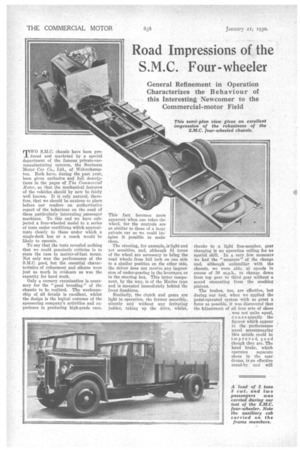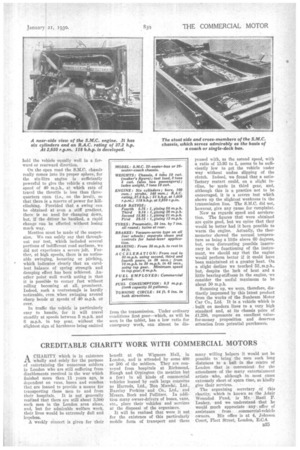Road Impressions of the S.M.C. Four-wheeler
Page 60

Page 61

If you've noticed an error in this article please click here to report it so we can fix it.
MWO S.M.C. chassis have been pro
duced and marketed by a special department of the famous private-carmanufacturing concern, the Sunbeam Motor Car Co., Ltd., of Wolverhampton. Both have, during the past year, been given exclusive and full descriptions in the pages of The Commercial Motor, so that the mechanical features of the vehicles should by now be fairly well known. It is only natural, therefore, that we should be anxious to place before our readers an authoritative report of the behaviour on the road of these particularly interesting passenger machines. To this end we have subjected a four-wheeled model to a series of tests under conditions which approximate closely to those under which a single-deck bus or a coach would be likely to operate.
To say that the tests revealed nothing that we could genuinely criticize is to state the case in matter-of-fact terms. Not only was the performance of the S.M.C. good, but the essential characteristics of refinement and silence were just as much in evidence as was the capacity for hard work.
Only a cursory examination is necessary for the " good breeding" of the chassis to be realized. The workmanship of all details is excellent, whilst the design is the logical outcome of the sponsoring company's activities and experience in producing high-grade cars. This fact becomes more apparent when one takes the wheel, for the controls are as similar to those of a large private car as we could imagine it possible to make them.
The steering, for example, is light and yet sensitive, and, although 41 turns of the wheel are necessary to bring the road wheels from full lock on one side to a similar position on the other side, the driver does not receive any impression of under-gearing in the leverages, or in the steering box. This latter component, by the way, is of the Merles type and is mounted immediately behind the front dumbiron.
Similarly, the clutch and gears are light in operation, the former smoothly, silently and without any irritating judder, taking up the drive, whilst, thanks to a light free-member, gear changing is an operation calling for no special skill. In a very few moments we had the " measure" of the change and, although unfamiliar with the chassis, we were able, at speeds in excess of 30 m.p.h., to change down from top gear to third gear without a sound emanating from the meshing pinions.
The brakes, too, are effective, but during our test, when we applied the pedal-operated system with as great a force as possible, it was discovered that the adjustment of all four sets of shoes . was not quite equal, consequently the figures which appear in the performance • panel accompanying this article could be improved, good though they are. The hand brake, which operates separate shoes in the rear drums, is an effective stand-by and will hold the vehicle equally well in a forward or rearward direction.
On the open road the S.M.C. chassis really comes into its proper sphere, for the six-litre engine is sufficiently powerful to give the vehicle a cruising speed of 40 m.p.h., at which rate of travel the throttle is less than threequarters open (i.e.,. on the level), so that there is a reserve of power for hillclimbing. Provided that a swing can be obtained at even, a stiff gradient, there is no need for changing down, but, if the driver be baulked, a rapid change can be effected without losing much way.
Mention ninst be made of the suspension. We can safely say that throughout our test, which included several portions of indifferent road surfaces, we did not experience a severe jolt. Further, at high speeds, there is no noticeable swinging, bouncing or pitching, • which indicates clearly that an excellent balance, of spring strength and damping effect has been achieved. Another point well worth noting is that it is possible to corner fast without rolling becoming at all. prominent. Indeed, such a contretemfis is hardly noticeable, even when swinging around sharp bends at speeds of 40 m.p.h. or over.
In traffic the vehicle is particularly easy to handle, for it will travel steadily at speeds between 5 m.p.h. and 6 m.p.h. in top gear, without the slightest sign of harshness being emitted from the transmission. Under ordinary conditions first gear—which, as will be seen in the tablet, has a low ratio for emergency work, can almost be dis pensed with, as the second speed, with a ratio of 15.93 to 1, seems to be sufficiently low to get the vehicle under way without undue slipping of the clutch. Indeed, we found that a satisfactory restart could, on a slight incline, be made in third gear, and, although this is a practice not to be encouraged, it is a severe test which shows up the slightest weakness in the transmission line. The S.M.C. did not, however, give any cause for complaint.
Now as regards speed and acceleration. The figures that were obtained are quite good, but we opine that they would be better had it been possible to warm the engine. Actually, the thermometer showed the normal temperature as being a little above 60 degrees, but, even discounting possible inaccuracy in the functioning of the instrument, -we should say that the engine would perform better if it could have been maintained at a greater heat. On a slight decline we touched 53. m.p.h., but, despite the lack of heat and a little bearing-stiffness in the engine,-we consider the useful maximum to be about 50 m.p.h.
Summing up, we were, therefore, distinctly impressed by this latest product from the works of the Sunbeam Motor Car Co., Ltd. It is a vehicle which is built on modern lines to a very high standard and, at its chassis price of £1,250, represents an excellent valuefor-money proposition and deserves attention from potential purchasers.




















































































































